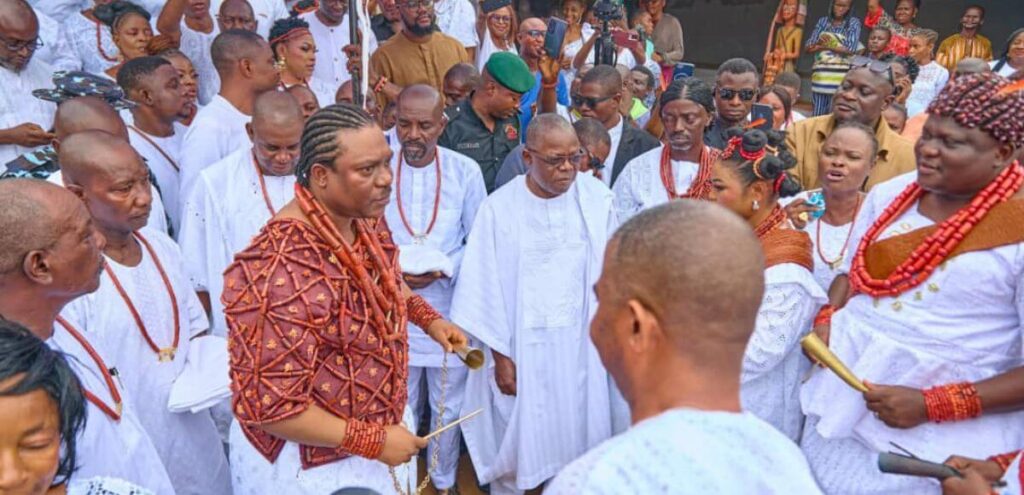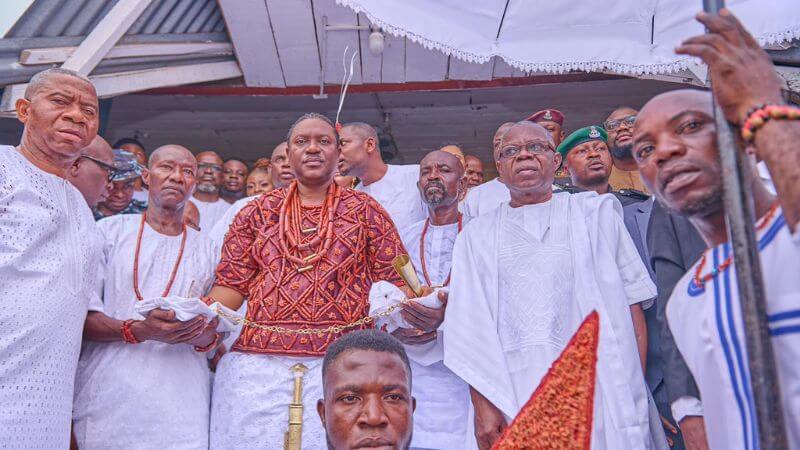The Igogo festival held annually in September in Owo, Ondo State, Nigeria, honors Queen Oronsen, the mythical wife of King Rerengejen. During this Yoruba celebration, the reigning Olowo of Owo and high chiefs pay homage by dressing in women’s attire – adorned with coral beads, beaded gowns, and plaited hair. Uniquely, the festival forbids headwear, drumming, and gunfire.
A testament to Oronsen’s legend emerged when a terracotta sculpture of the queen was unearthed from the Igbo Oluwa forest by Nigerian scholar Ekpo Eyo. This discovery served as a symbolic reminder of her permanent departure from the palace. However, the statue also conveyed a promise: in exchange for an annual offering of two hundred diverse items – including dried fish, alligator pepper, kola nuts, and bitter cola – Oronsen would perpetually safeguard the kingdom.
The 17-day Igogo festival kicks off with the Upeli procession, led by the Akowa of Iloro, the head of the Iloro chiefs. Spanning 12 days, this procession features various ceremonies like Utegi, Ugbabo, Uyanna, and Ugbate. It also coincides with the celebration of the new yam harvest.
Uniquely, the festival prohibits drumming and headwear for both men (caps) and women (head ties) near the Owo monarch. A captivating spectacle unfolds as bare-chested Igharo men, from the Iloro Quarter, take center stage. Dressed in white caps and brandishing buffalo horns, they dance through the town and sacred sites, striking the horns together in rhythmic harmony. Any animal encountered during their dance becomes part of the celebratory feast.
History of the Igogo Festival

The Igogo festival began over 600 years ago during the reign of the late Olowo Rerengejen. The monarch married Oronsen, a beautiful and affluent queen who had, unknown to the king, supernatural powers. She enriched the monarch and she was loved by the monarch.
Queen Oronsen insisted on certain taboos. She insisted that nobody should grind Okra in her presence or pour water into the yard. In addition, anyone arriving from the farm must not lump a load of firewood. King Rerengejen cautioned his other wives not to carry out any of these activities.
One day, Queen Oronsen had a rift with the other senior wives of the King. They conspired against her to violate her taboo while Rerengejen was not in the palace. Her taboo was violated and she left the palace.
While she was running out of the palace, some palace guards and chiefs ran after her to bring her back, a futile effort. She later felt tired and waited at a place called “Ugbo Laja” where she was persuaded to return to the palace. Her refusal frustrated the guards into forcefully capturing her but she disappeared into “Igbo Oluwa”, now a sacred forest, leaving her head ties (oja) at “Ugbo Laja” which the guards returned to King Rerengejen.
“Ugbo Laja” is now a sacred grove. Queen Orosen’s terra cotta sculptured image from “Igbo Oluwa” by Ekpo Eyo stood at a distance to inform the Owo people that nothing would bring her back to the palace but that annually they should always sacrifice two hundred items of different articles, such as dried fish, kolanut, Aligator pepper, bitter cola and many more for ritual (Igogo) and in return she promised to protect the Kingdom.
Igodo Festival – event highlights
The Igogo festival lasts for 17 days and begins with Upeli proceedings by the Iloro chiefs. The chiefs are led by “Akowa” known as “Akowa of Iloro” who is the head of Iloro chiefs. This Upeli procession lasts for days and features several activities including Utegi, Ugbabo, Uyanna, and Ugbate. It is also a period for the celebration of new yams.
During this procession, the booming of drums by individuals or associations is forbidden and the use of caps by men and head ties by women at close range to the Owo monarch, the Olowo of Owo is forbidden.
The festival features the dance of bare-chested men known as ayoyos, the Iloro Quarter men called Ighares. They often wear white/gray painted calabash-made caps with two horns of Bufallo in their hands. They struck these horns together while dancing around the town and visiting some sacred places in the town.
During this rite, any animal that crosses their part automatically becomes their delicacy. The chief plaits their hair and dances around the town and visits their loved ones who will give them a gift in return. The monarchs often dress like women and dance around the town. Dancing in the market by the monarch is also one of the rites performed during the festival.
The time of the event was the period of the annual yam festival, but because of the happenings (Oronsen saga), the Igogo was incorporated alongside the yam festival which has now overshadowed the yam festival. The Olowo still celebrates the yam festival as part of the rites/events during the Igogo. A day after Olowo’s Igogo is set aside for the yam festival, on that day the Olowo feasts the Owo people with OBETE (asaro) yam porridge.
Major significance of the event
- Commemoration of Queen Orosen: The igodo festival is a symbolic commemoration of Queen Orosen, a wife of the first Olowo, Rerengenjen, who fled the palace due to jealousy and envy from other wives.
- Symbol of Unity and Culture: The Igogo festival is a time for the Owo community, both home-based and in the Diaspora, to come together and celebrate their cultural heritage.
- Exchange of Gifts: A unique aspect of the festival is the exchange of gifts, including cash, food items, and other goods, from various organizations, individuals, and groups to the Olowo.
- Ban on Drums: During the festival period, drums are banned in Owo, and instead, metal gongs (agogo) are used, which is where the name “Igogo” is derived.
- Encouraging Youth Involvement: The festival aims to encourage greater involvement of the community’s youth in their cultural norms.
Final Thoughts
The Igogo festival of the Owo Kingdom, remains one of Nigeria’s most revered cultural heritage, with interesting historic significance. The 17-day event begins with the “Upeeli” procession led by the Iloro chiefs, including activities like Utegi, Ugbabo, Uyanna, Ugbate, and the blessing of the new yam.



